TiNb Alloy Powder
$0.00
TiNb Alloy Powder
| Product | TiNb Alloy Powder |
| CAS No. | 12010-55-8 |
| Appearance | Gray-Silver Powder |
| Purity | ≥99%, ≥99.9%, ≥95%(Other purities are also available) |
| APS | 1-5 µM, 10-53 µM (Can be customized), Ask for other available size range. |
| Ingredient | Ti-Nb |
| Density | 4.5-5.5g/cm3 |
| Molecular Weight | N/A |
| Product Codes | NCZ-DCY-322/25 |
TiNb Alloy Description:
TiNb Alloy Powder is one of the numerous advanced ceramic materials manufactured by Nanochemazone. Nanochemazone produces too many standard grades when applicable, including Mil Spec (military grade); ACS, Reagent and Technical Grade; Food, Agricultural and Pharmaceutical Grade; Optical Grade, USP and EP/BP (European Pharmacopoeia/British Pharmacopoeia) and follows applicable ASTM testing standards. Typical and custom packaging is available. Additional technical, research and safety (MSDS) information are available. Please request a quote above for more information on lead time and pricing.
TiNb Alloy Powder Related Information :
Storage Conditions:
Airtight sealed, avoid light and keep dry at room temperature.
Please contact us for customization and price inquiry
Email: [email protected]
Note: We supply different size ranges of Nano and micron as per the client’s requirements and also accept customization in various parameters.
TiNb Alloy Powder
Titanium niobium (TiNb) alloy powder is an advanced material with excellent properties for use in biomedical, aerospace, automotive and other demanding applications. This article provides a comprehensive guide to TiNb alloy powder covering composition, properties, processing, applications, specifications, suppliers, costs, handling and more.
Introduction to TiNb Alloy Powder
TiNb alloy powder is composed of titanium and niobium metals. It offers a unique combination of high strength, low density, biocompatibility, corrosion resistance, fatigue and creep resistance at high temperatures.
TiNb alloys are part of a broader class of titanium intermetallic materials that have superior physical, chemical and mechanical properties compared to pure titanium. The addition of niobium as an alloying element enhances certain properties and allows tailoring TiNb alloys for specific applications.
Some key advantages of TiNb alloy powder include:
High strength-to-weight ratio
Ability to withstand extreme temperatures and stresses
Resists wear, abrasion and corrosion in harsh environments
Biocompatible and non-toxic for medical uses
Can be processed into complex shapes using additive manufacturing
Provides design flexibility for engineers
TiNb alloys compete with nickel and cobalt-based superalloys in the aerospace industry. They also offer an alternative to stainless steels for biomedical implants and devices. TiNb alloys are enabling new applications and designs not possible with other materials.
This article provides a technical reference covering the composition, properties, processing, applications, specifications, costs and other practical aspects of TiNb alloy powder.
TiNb Alloy Powder Composition
TiNb alloys contain primarily titanium and niobium as the key constituent elements. The niobium content typically ranges from 10% to 50% by weight, with the balance being titanium.
The ratio of Ti to Nb can be adjusted to create different grades of TiNb alloys optimized for certain properties. Some common TiNb grades include:
Ti-10Nb – 10% niobium, 90% titanium
Ti-35Nb – 35% niobium, 65% titanium
Ti-45Nb – 45% niobium, 55% titanium
Ti-50Nb – 50% niobium, 50% titanium
Additionally, small amounts of other elements like zirconium, tantalum, molybdenum, chromium may be added to further enhance properties. Oxygen and nitrogen may also be present as impurities.
Table 1: Chemical composition of common TiNb alloy grades
| Alloy Grade | Niobium Content | Titanium Content |
| Ti-10Nb | 10% | 90% |
| Ti-35Nb | 35% | 65% |
| Ti-45Nb | 45% | 55% |
| Ti-50Nb | 50% | 50% |
Controlling the composition is critical to achieve the desired properties in the final TiNb alloy product. Powder metallurgy techniques allow precise mixing of the constituent metals into an alloy powder feedstock.
TiNb Alloy Powder Properties
TiNb alloys exhibit a range of useful physical, mechanical and chemical properties that make them suitable for high performance applications. Some key properties include:
Physical Properties
Density – 4.5 to 5.5 g/cm3, lower than steel and nickel alloys
Melting point – 1550 to 1750°C depending on composition
Electrical resistivity – 0.5 to 0.6 μΩ.m, higher than pure titanium
Thermal conductivity – 6 to 22 W/m.K, lower than titanium
Mechanical Properties
Tensile strength – 500 to 1100 MPa, increases with niobium content
Yield strength – 300 to 900 MPa
Elongation – 10% to 25%
Hardness – 200 to 350 HV
Fatigue strength – 400 to 600 MPa
Other Properties
Corrosion resistance – Excellent due to protective oxide layer
Wear resistance – Better than titanium due to hardness
Biocompatibility – Non-toxic and non-allergenic
By adjusting the Ti/Nb ratio, properties like strength, ductility, hardness and elastic modulus can be optimized as per application requirements.
Table 2: Typical properties of Ti-35Nb alloy
| Property | Value |
| Density | 5.2 g/cm3 |
| Melting point | 1600°C |
| Tensile strength | 650 MPa |
| Yield strength | 550 MPa |
| Elongation | 15% |
| Elastic modulus | 60 GPa |
| Hardness | 250 HV |
TiNb Alloy Powder Applications
The unique properties of TiNb alloys make them suitable for demanding applications in various industries:
Aerospace
Engine components – blades, discs, fasteners
Airframe parts – landing gear, wings, fuselage
Hydraulic systems – pumps, valves, actuators
Automotive
Valve springs, engine valves
Connecting rods, turbocharger rotors
Motor racing components
Biomedical
Orthopedic implants – knee, hip
Dental implants, crowns
Surgical instruments
Medical devices
Chemical Industry
Heat exchangers, reactors
Pumps, valves, pipes
Corrosion-resistant equipment
Other Applications
Sporting goods – golf clubs, bike frames
High-end watches and jewelry
Electrical contacts and connectors
High temperature furnace parts
The combination of strength, temperature resistance, corrosion resistance and biocompatibility allows TiNb alloys to substitute heavier materials across these industries.
Table 3: TiNb alloy applications by industry
| Industry | Applications |
| Aerospace | Engine components, airframe parts, hydraulic systems |
| Automotive | Valve springs, engine valves, connecting rods |
| Biomedical | Implants, dental, surgical instruments, devices |
| Chemical | Heat exchangers, reactors, pumps, valves |
| Other | Sporting goods, watches, electrical contacts, furnace parts |
TiNb Alloy Powder Processing
TiNb alloy powder can be produced via different processing routes:
Metal Powder Blending
elemental titanium and niobium powders are blended together in the required composition
blended powder mixture is mechanically alloyed to form the TiNb alloy powder
Gas Atomization
molten TiNb alloy is atomized with an inert gas into fine droplets
droplets solidify into spherical alloy powder particles
Plasma Rotating Electrode Process (PREP)
TiNb electrode rod is melted using plasma arc and spun at high speeds
centrifugal force causes droplets to break off and solidify into particles
Hydride-Dehydride (HDH) Method
Ti and Nb metals are converted into brittle hydride powders
hydride powders are blended, dehydrided, crushed and sieved
The particle size, morphology, flowability and microstructure of the powder can be controlled by selecting the appropriate manufacturing process. This influences the final properties after consolidation.
Table 4: TiNb alloy powder production methods
| Method | Description | Particle Size | Morphology |
| Mechanical alloying | Blending and milling Ti and Nb powders | 10 – 50 microns | Irregular, angular |
| Gas atomization | Inert gas atomization of molten alloy | 15 – 150 microns | Spherical |
| Plasma rotating electrode | Centrifugal disintegration of melted electrode | 50 – 150 microns | Spherical |
| HDH process | Hydriding, dehydriding, crushing blended powders | 10 – 63 microns | Irregular, angular |
Consolidation of TiNb Alloy Powder
TiNb alloy powder can be converted into full-density components using various powder metallurgy consolidation techniques:
Hot Isostatic Pressing (HIP)
encapsulated powder is HIP ped at high temperature and pressure
Vacuum Sintering
powder is compacted and sintered in vacuum furnace
Spark Plasma Sintering
powder is simultaneously heated and compressed by pulsed DC current
Metal Injection Molding (MIM)
powder is mixed with binder, molded, debinded and sintered
Additive Manufacturing
powder bed fusion (SLM, EBM) or directed energy deposition (DED)
HIP and vacuum sintering can achieve close to full density while retaining fine microstructure. Additive manufacturing offers greater geometric freedom. The consolidation process can be optimized to achieve the desired properties.
Table 5: TiNb alloy powder consolidation techniques
| Method | Description | Density | Microstructure | Geometry |
| HIP | High pressure, high temperature | Near full density | Fine | Simple shapes |
| Vacuum sintering | Sintering in vacuum furnace | Near full density | Fine | Simple shapes |
| Spark plasma sintering | Pulsed current and pressure | Full density | Ultrafine | Simple shapes |
| Metal injection molding | Powder + binder molding | Near full density | Ultrafine | Complex shapes |
| Additive manufacturing | Powder bed fusion or directed energy deposition | Near full density | Coarse | Complex shapes |
Specifications for TiNb Alloy Powder
TiNb alloy powder is available in various specifications tailored for different applications:
Compositions: Grades with 10% to 50% niobium content
Particle Size: 10 to 150 microns
Morphology: Spherical, irregular or blended
Production Method: Gas atomized, HDH, blended elemental
Purity: >99.5% titanium, >99.8% niobium
Oxygen Content: <2000 ppm
Flowability: Hall flow rate > 23 sec/50g
Apparent Density: ≥ 2.5 g/cc
Tap Density: ≥ 3.5 g/cc
Chemical composition, particle size distribution, morphology, flow rate and density are commonly specified properties. Custom alloys and powder specifications can be produced for specific applications.
Table 6: Typical specification of Ti-35Nb gas atomized powder
| Parameter | Specification |
| Alloy composition | Ti-35Nb |
| Particle size | 15 to 45 microns |
| Morphology | Spherical |
| Production method | Gas atomization |
| Purity | Ti >99.5%, Nb >99.8% |
| Oxygen content | <1500 ppm |
| Flow rate | >38 sec/50g |
| Apparent density | ≥ 2.7 g/cc |
| Tap density | ≥ 4.2 g/cc |
Handling and Storage of TiNb Alloy Powder
As a reactive metallic powder, some care is needed when handling TiNb alloy powder:
Store in sealed containers in a dry, inert atmosphere to prevent oxidation and contamination
Avoid contact with oxygen, moisture, oils, combustible materials
Prevent accumulation of fine powders on surfaces or equipment
Ground all conductive equipment used in handling
Use spark-proof tools and minimize dust generation
Wear gloves and respiratory protection when handling
Use grounded ventilation systems and avoid dust clouds
Keep away from heat, flames, sparks and other ignition sources
Follow safety data sheet for proper PPE and precautions
If stored properly in a dry, inert atmosphere, TiNb alloy powder has a typical shelf life of 12 months. Improper storage conditions can lead to oxidation, loss of flowability, or ignition hazards.
Table 9: TiNb alloy powder handling guidelines
| Parameter | Guidelines |
| Storage | Sealed containers, dry inert atmosphere |
| Atmosphere | Avoid oxygen, moisture, oils, combustibles |
| Equipment | Ground all conductive equipment |
| Tools | Use non-sparking tools |
| Ventilation | Grounded ventilation system |
| PPE | Gloves, respiratory protection |
| Precautions | Avoid heat, flames, sparks |
| Shelf life | 12 months in inert atmosphere |
Safety Data Sheet for TiNb Alloy Powder
Like other reactive metal powders, some important safety precautions for TiNb alloy:
Wear PPE – gloves, eye protection, mask/respirator
Avoid inhalation of powders – use respiratory protection
Avoid contact with skin and eyes
Wash thoroughly after handling powder
Avoid ignition sources, powders may be flammable
Use proper grounding and ventilation
Inert storage atmosphere to prevent oxidation
Avoid spills and dust accumulation on surfaces
Follow instructions on SDS and warning labels
First aid:
Inhalation: Move to fresh air. Get medical help if needed.
Skin contact: Wash with soap and water. Get help if irritation persists.
Eye contact: Flush eyes with water for 15 minutes. Get medical attention.
Ingestion: Drink water. Get medical assistance if discomfort occurs.
Always refer to SDS from supplier for complete health and safety information before handling and processing TiNb alloy powder.
Table 10: Key safety measures for TiNb alloy powder
| Safety Item | Precautions |
| PPE | Gloves, goggles, N95 mask |
| Inhalation | Use respiratory protection |
| Skin contact | Wash affected area with soap and water |
| Eye contact | Flush eyes with water for 15 minutes |
| Ingestion | Drink water. Get medical help if needed. |
| Ventilation | Use grounded ventilation hoods |
| Grounding | Ground all equipment during handling |
| Ignition | Avoid sparks, flames, heat sources |
| Storage | Inert atmosphere away from flammable materials |
Quality Inspection of TiNb Alloy Powder
To ensure TiNb alloy powder meets specifications, various quality checks are performed:
Chemical analysis – ICP, GDMS or LECO analysis to verify composition and purity
Particle size analysis – laser diffraction or sieve analysis for size distribution
Morphology – SEM imaging to check particle shape and surface topology
Flow rate – Hall flow meter test for powder flowability
Density – apparent density and tap density measurements
Oxygen/nitrogen – inert gas fusion analysis for interstitial impurities
Phase identification – XRD analysis to determine phases present
Powder properties are tested on each batch to quality standards like ASTM B939, ASTM F3049, EN 10204 3.1. Powder can be blended between lots to achieve uniformity.
Table 11: Testing methods for TiNb alloy powder
| Test | Method | Standard |
| Composition | ICP, GDMS, LECO | ASTM E1479, ASTM E2330 |
| Particle size distribution | Laser diffraction, sieving | ASTM B822 |
| Morphology | SEM imaging | ASTM B822 |
| Flow rate | Hall flow meter | ASTM B213 |
| Density | Scott volumeter | ASTM B212 |
| Oxygen/Nitrogen | Inert gas fusion | ASTM E1019 |
| Phase analysis | X-ray diffraction | ASTM E1876 |
Medical Applications of TiNb Alloy
Due to their biocompatibility, high strength and low modulus, TiNb alloys are widely used for medical implants and devices:
Orthopedic Implants
Knee and hip replacements
Bone plates, screws
Spinal fixation devices
Dental implants and bridges
TiNb alloys like Ti-35Nb and Ti-45Nb match the elastic modulus of human bone while providing high fatigue strength. This reduces stress shielding compared to stiffer titanium alloys.
Cardiovascular Devices
Stents
Pacemaker casings
Guidewires
Surgical instruments
The corrosion resistance, non-toxicity and non-magnetism of TiNb alloys make them suitable for devices that contact blood and tissues.
TiNb Alloy Grades for Medical Use
Ti-10Nb to Ti-50Nb
Ti-Nb-Zr, Ti-Nb-Ta for adjusted properties
ISO 5832-11 and ASTM F2066 standards
Lower modulus Ti-35Nb and Ti-45Nb are commonly used. Higher Nb strengthens but increases modulus. Small Zr/Ta additions further tailor properties.
Advantages of TiNb Alloys for Biomedical Use
Excellent biocompatibility and osseointegration
High strength and fatigue resistance
Low modulus close to bone
Non-toxic, non-allergenic
Corrosion resistant
Non-magnetic
TiNb alloys provide the best combination of strength, biocompatibility, corrosion resistance and elastic modulus for implants.
Challenges of TiNb Alloy Medical Components
Difficult machining and fabrication
Costlier than Ti-6Al-4V alloy
Requires rigorous quality control and testing
Longer-term clinical data still evolving
Being relatively new for medical use, manufacturing and licensing of TiNb components can be more complex. But their advantages outweigh short-term challenges.
Automotive Use of TiNb Alloys
The high strength, temperature resistance and fatigue life of TiNb alloys make them attractive for automotive parts:
Valve Springs
Higher strength allows lower spring mass
Reduces valve float at high RPM
Allows higher power output
Engine Valves
Withstands high temperature exhaust gases
Resists wear and deformation
Lightweight
Connecting Rods
High strength-to-weight ratio
Reduces reciprocating mass
Allows higher RPM and power
Turbocharger Rotors
Maintains strength at high temperatures
Resists creep deformation
Thermal shock resistance
Low density
Motor Racing Components
Lightweight suspension, chassis parts
Superior fatigue life
Reduced mass and inertia combined with temperature and fatigue resistance lead to higher engine performance and efficiency.
Challenges of TiNb Alloys for Automotive
High cost compared to steel alloys
Processing difficulties with powder metallurgy
Limited suppliers and manufacturing experience
Uncertain cost-benefit ratio
The benefits may justify premium pricing for high-end vehicles and motorsports initially. Broader adoption depends on TiNb powder producers driving down costs.
Aerospace Applications of TiNb Alloys
TiNb alloys compete with nickel superalloys for aircraft engine and airframe applications needing strength at low temperatures:
Engine Components
Turbine blades, discs, casings
Compressor blades
Shafts, fasteners
Thrust reversers
Structural Parts
Landing gear
Wings, ribs, stringers
Fuselage frames
Hydraulic tubing
Benefits
30-50% lower density than Ni superalloys
Saves weight
Similar strength and creep resistance
Withstands high stresses and temperatures
Challenges
Higher costs than titanium alloys currently
Processing difficulties compared to wrought alloys
Limited production experience and availability
Property data still evolving
The aerospace industry is conservative, so extensive testing and qualification programs are needed to prove viability and establish supply chains before adopting new alloys like TiNb.
Other Applications of TiNb Alloys
In addition to medical, automotive and aerospace uses, TiNb alloys are also suitable for:
Marine – Propellers, pump shafts, fittings
Chemical – Heat exchangers, condensers, piping
Sporting goods – Golf clubs, bicycle frames, rackets
Power generation – Steam and gas turbine components
Electronics – Sputtering targets, capacitors
Jewelry – Watches, rings, piercings
Oil and gas – Downhole tools, valves, pumps
The corrosion resistance, biocompatibility and electrical properties expand the utility of TiNb alloys across diverse industries.
Continuing research and development will uncover new applications as manufacturing experience with TiNb alloy powder grows. Their unique balance of properties will enable designs not feasible with other materials.
Future Outlook for TiNb Alloys
Expanding medical use driven by aging population and need for better implants
Category: Titanium Based Alloy Powder
Description
Description
Note: For pricing & ordering information, please get in touch with us at [email protected]
Please contact us for quotes on Larger Quantities and customization. E-mail: [email protected]
Customization:
If you are planning to order large quantities for your industrial and academic needs, please note that customization of parameters (such as size, length, purity, functionalities, etc.) is available upon request.
NOTE:
Images, pictures, colors, particle sizes, purity, packing, descriptions, and specifications for the real and actual goods may differ. These are only used on the website for the purposes of reference, advertising, and portrayal. Please contact us via email at [email protected] or by phone at (+1 780 612 4177) if you have any
Reviews (0)
Only logged in customers who have purchased this product may leave a review.
Shipping & Delivery
Related products
CPTi Powder
$0.00
CPTi Powder
| Product | CPTi Powder |
| CAS No. | 12083-20-1 |
| Appearance | White -Silvery Powder |
| Purity | ≥99%, ≥99.9%, ≥95%(Other purities are also available) |
| APS | 1-5 µM, 10-53 µM (Can be customized), Ask for other available size range. |
| Ingredient | Cp-Ti |
| Density | 4.51g/cm3 |
| Molecular Weight | 41.86g/mol |
| Product Codes | NCZ-DCY-312/25 |
CPTi Description:
CPTi Powder is one of the numerous advanced ceramic materials manufactured by Nanochemazone. Nanochemazone produces too many standard grades when applicable, including Mil Spec (military grade); ACS, Reagent and Technical Grade; Food, Agricultural and Pharmaceutical Grade; Optical Grade, USP and EP/BP (European Pharmacopoeia/British Pharmacopoeia) and follows applicable ASTM testing standards. Typical and custom packaging is available. Additional technical, research and safety (MSDS) information are available. Please request a quote above for more information on lead time and pricing.CPTi Powder Related Information :
Storage Conditions: Airtight sealed, avoid light and keep dry at room temperature. Please contact us for customization and price inquiry Email: [email protected] Note: We supply different size ranges of Nano and micron as per the client’s requirements and also accept customization in various parameters. CPTi Powder CPTi (chemically pure titanium) powder is a high purity titanium metal powder used in various applications requiring excellent corrosion resistance, high strength, low weight, and biocompatibility. It offers superior properties compared to other titanium grades and alloy powders. Overview of CPTi Powder CPTi (chemically pure titanium) powder is a high purity titanium metal powder used in various applications requiring excellent corrosion resistance, high strength, low weight, and biocompatibility. It offers superior properties compared to other titanium grades and alloy powders. CPTi powder is produced by gas atomization process to achieve spherical powder morphology with minimal contamination. It has a particle size range of 15-150 microns generally. The high purity and cleanliness result in excellent flowability, packing density and sinterability. Some key properties and advantages of CPTi powder include: CPTi Powder Properties and Characteristics| Properties | Details |
| Composition | 99.5% minimum Titanium. Low O, C, N, H, Fe impurities |
| Density | 4.5 g/cc |
| Flowability | Excellent due to spherical morphology |
| Sinterability | Excellent, achieves near full density |
| Particle shape | Predominantly spherical |
| Particle size range | 15-150 microns |
| Apparent density | 2.7-3.2 g/cc |
| Purity | Up to 99.995% Ti content |
| Impurities | Low oxygen, nitrogen, carbon, iron |
| Color | Dark gray with metallic luster |
| Element | Weight % |
| Titanium | 99.5% min |
| Oxygen | 0.08% – 0.40% |
| Carbon | 0.03% – 0.08% |
| Nitrogen | 0.01% – 0.05% |
| Hydrogen | 0.005% – 0.015% |
| Iron | 0.05% – 0.25% |
| Grade | Purity | Particle Size | Applications |
| CPTi Grade 1 | 99.5% min | Medium, large | General use |
| CPTi Grade 2 | 99.9% | Fine, medium | Aerospace, medical |
| CPTi Grade 3 | 99.95% | Fine | Medical, dental |
| CPTi Grade 4 | 99.99% | Ultrafine | Implants, high purity uses |
| Properties | Values |
| Density | 4.5 g/cc |
| Melting point | 1668°C |
| Thermal conductivity | 21.9 W/mK |
| Electrical resistivity | 53.8 ohm-cm |
| Young’s modulus | 107 GPa |
| Poisson’s ratio | 0.33 |
| Mohs hardness | 6 |
| Oxidation resistance | Up to 590°C in air |
| Properties | Values |
| Tensile strength | 420 – 550 MPa |
| Yield strength | 380 – 470 MPa |
| Elongation | 15 – 30% |
| Hardness | 200-240 HV |
| Fatigue strength | 200-300 MPa |
| Industry | Application Examples |
| Aerospace | Engine components, airframe parts, fasteners |
| Medical | Implants, prosthetics, instruments |
| Automotive | Valves, connecting rods, springs |
| Chemical | Pumps, valves, tanks, pipes |
| 3D printing | Aerospace and medical components |
| Metal injection molding | Dental instruments, hardware |
| Investment casting | Turbine blades, golf club heads |
| Standard | Description |
| ASTM B348 | Standard specification for titanium and titanium alloy powders |
| ASTM F67 | Standard specification for unalloyed titanium bars for surgical implants |
| ISO 5832-2 | Implant grade wrought titanium materials |
| Particle size | Typical size range | Applications |
| Fine | 1-25 microns | Investment casting, MIM |
| Medium | 25-45 microns | Press and sinter, HIP |
| Coarse | 45-150 microns | Thermal and cold spraying |
| Apparent Density | Characteristics |
| 2.7 – 3.0 g/cc | Unalloyed CPTi powder |
| 3.0 – 3.2 g/cc | Alloyed CPTi powder |
| Up to 50% of true density | Due to voids between particles |
| Method | Details |
| Gas atomization | High pressure argon gas disintegrates molten Ti stream into fine droplets, which solidify into spherical powder |
| Vacuum arc melting | High purity Ti input stock is refined to reduce gaseous impurities like O, N, H |
| Multiple melting | Ensures chemical homogeneity of raw material |
| Sieving | Classifies powder into different particle size distributions |
| Blending | Powders with different particle sizes are mixed in optimized ratios |
| Recommendation | Reason |
| Avoid inhalation | Due to small particle size |
| Use protective masks | Prevent ingestion through nose/mouth |
| Conduct handling in ventilated areas | Reduce airborne powder circulation |
| Use hazmat suits in large operations | Minimize skin contact |
| Ensure no ignition sources nearby | Powder can combust in oxygen atmosphere |
| Follow anti-static protocols | Prevent accidental fire due to buildup of static charge |
| Use non-sparking tools | Avoids possibility of ignition during handling |
| Store sealed containers in cool, dry area | Prevents moisture pickup and reactivity |
| Test | Details |
| Chemistry analysis | ICP spectroscopy verifies elemental composition |
| Particle size distribution | Sieve analysis determines size distribution |
| Apparent density | Measured as per ASTM B212 standard |
| Powder morphology | Scanning electron microscopy verifies spherical shape |
| Flow rate | Time taken for fixed powder quantity to flow through defined nozzle |
| Tap density | Density measured after mechanically tapping powder sample |
| Compressibility | Monitoring of powder bed density change during compression |
| Factor | Effect |
| Air, oxygen | Moderate oxidation risk above 500°C |
| Moisture | Low corrosion rate at room temperature |
| Hydrocarbons | Risk of fire if allowed to contaminate powder |
| Acids, bases | Low corrosion rates in neutral solutions |
| Organic solvents | Some absorption and discoloration if immersed |
| Elevated temperatures | Increased reactivity with oxygen and nitrogen |
| Parameter | CPTi Powder | Ti-6Al-4V Powder |
| Density | 4.5 g/cc | 4.42 g/cc |
| Tensile strength | 420 – 550 MPa | 950 – 1050 MPa |
| Ductility | 15 – 30% | 10 – 18% |
| Fatigue strength | 200 – 300 MPa | 500 – 600 MPa |
| Corrosion resistance | Excellent | Moderate |
| Oxidation resistance | Excellent | Good |
| Cost | Low | Moderate |
| Toxicity | None | Low |
| Uses | Low temperature applications, prosthetics | Aerospace components, automotive parts |
PREF Refractory Titanium Alloy Powder
$0.00
PREF Refractory Titanium Alloy Powder
| Product | PREF Refractory Titanium Alloy Powder |
| CAS No. | 7440-32-6 |
| Appearance | Grey Powder |
| Purity | ≥99%, ≥99.9%, ≥95%(Other purities are also available) |
| APS | 1-5 µM, 10-53 µM (Can be customized), Ask for other available size range. |
| Ingredient | TiTaNbZr |
| Density | 2.53g/cm3 |
| Molecular Weight | N/A |
| Product Codes | NCZ-DCY-313/25 |
PREF Refractory Titanium Alloy Description:
PREF Refractory Powder is one of the numerous advanced ceramic materials manufactured by Nanochemazone. Nanochemazone produces too many standard grades when applicable, including Mil Spec (military grade); ACS, Reagent and Technical Grade; Food, Agricultural and Pharmaceutical Grade; Optical Grade, USP and EP/BP (European Pharmacopoeia/British Pharmacopoeia) and follows applicable ASTM testing standards. Typical and custom packaging is available. Additional technical, research and safety (MSDS) information are available. Please request a quote above for more information on lead time and pricing.PREF Refractory Powder Related Information :
Storage Conditions: Airtight sealed, avoid light and keep dry at room temperature. Please contact us for customization and price inquiry Email: [email protected] Note: We supply different size ranges of Nano and micron as per the client’s requirements and also accept customization in various parameters. PREP Refractory Titanium Alloy Powder TiAl is a new class of aerospace alloys that offers an excellent strength-to-weight ratio as well as high chemical and thermal stability. Gamma titanium aluminide alloy has excellent mechanical properties as well as oxidation and corrosion resistance at elevated temperatures (over 600 degrees Celsius). TiAl is the latest class of materials competing with Nickel superalloys for the fabrication of aircraft engine parts such as low-pressure turbine. Overview of PREP Refractory Titanium Alloy Powder PREP (Plasma Rotating Electrode Process) alloy is a high-performance refractory titanium alloy powder designed for additive manufacturing of components needing excellent mechanical properties at extreme temperatures. This article provides a comprehensive guide to PREP titanium alloy powder covering composition, properties, print parameters, applications, specifications, suppliers, handling, inspection, comparisons, pros and cons, and FAQs. Quantitative information is presented in easy-to-reference tables. Composition of PREP Titanium Alloy Powder PREP alloy has a complex composition containing various solute elements:| Element | Weight % | Purpose |
| Titanium | Balance | Principal matrix element |
| Aluminum | 5 – 7 | Solid solution strengthener |
| Tin | 1 – 3 | Solid solution strengthener |
| Zirconium | 0.5 – 2 | Grain structure control |
| Molybdenum | 1 – 3 | Solid solution strengthener |
| Silicon | 0.5 – 1.5 | Oxidation resistance |
| Niobium | 1 – 3 | Carbide former |
| Tantalum | 1 – 3 | Carbide former |
| Property | Description |
| High strength | Excellent tensile and creep strength up to 700°C |
| Fatigue resistance | High fatigue life at elevated temperatures |
| Fracture toughness | Up to 100 MPa-√m |
| Oxidation resistance | Forms protective oxide scale |
| Thermal stability | Microstructural stability after prolonged exposures |
| Damage tolerance | Resistant to crack growth |
| Biocompatibility | Non-toxic and non-allergenic |
| Parameter | Typical Value | Purpose |
| Layer height | 30-50 μm | Resolution versus build speed |
| Laser power | 150-500 W | Sufficient melting without evaporation |
| Scan speed | 750-1500 mm/s | Density versus production rate |
| Hatch spacing | 80-120 μm | Mechanical properties |
| Hot isostatic pressing | 900°C, 100 MPa, 3 hrs | Eliminate internal voids |
| Industry | Components |
| Aerospace | Turbine blades, compressor parts, mounts |
| Automotive | Connecting rods, valves, turbocharger wheels |
| Medical | Orthopedic implants, surgical tools |
| Chemical | Pumps, valves, reaction vessels |
| Power generation | Hot gas path components |
| Parameter | Specification |
| Particle size range | 15-45 μm typical |
| Particle shape | Spherical morphology |
| Apparent density | >2.5 g/cc |
| Tap density | >4.5 g/cc |
| Hall flow rate | >35 sec for 50 g |
| Purity | >99.95% |
| Oxygen content | <1000 ppm |
| Method | Parameters Tested |
| Sieve analysis | Particle size distribution |
| SEM imaging | Particle morphology |
| EDX | Chemistry/composition |
| XRD | Phases present |
| Pycnometry | Density |
| Hall flow rate | Powder flowability |
| Alloy | Strength | Oxidation Resistance | Cost | Printability |
| PREP | Excellent | Excellent | High | Good |
| Ti64 | Good | Good | Medium | Fair |
| Ti6242 | Excellent | Good | High | Fair |
| CP-Ti | Low | Excellent | Low | Excellent |
| Pros | Cons |
| Outstanding high temperature strength | Expensive compared to Ti64 and CP-Ti |
| Excellent thermomechanical fatigue resistance | Higher density than other titanium alloys |
| Complex geometries feasible | Controlled atmosphere handling mandatory |
| Lower anisotropy than Ti64 and CP-Ti | Processing very technique sensitive |
| Matching properties to PREP wrought forms | Limited suppliers and alloy variants |
Pure Titanium Powder
$0.00
Pure Titanium Powder
| Product | Pure Titanium Powder |
| CAS No. | 7440-32-6 |
| Appearance | Silvery Powder |
| Purity | ≥99%, ≥99.9%, ≥95%(Other purities are also available) |
| APS | 1-5 µM, 10-53 µM (Can be customized), Ask for other available size range. |
| Ingredient | Ti |
| Density | 4.54g/cm3 |
| Molecular Weight | 47.86g/mol |
| Product Codes | NCZ-DCY-314/25 |
Pure Titanium Description:
Pure Titanium Powder is one of the numerous advanced ceramic materials manufactured by Nanochemazone. Nanochemazone produces too many standard grades when applicable, including Mil Spec (military grade); ACS, Reagent and Technical Grade; Food, Agricultural and Pharmaceutical Grade; Optical Grade, USP and EP/BP (European Pharmacopoeia/British Pharmacopoeia) and follows applicable ASTM testing standards. Typical and custom packaging is available. Additional technical, research and safety (MSDS) information are available. Please request a quote above for more information on lead time and pricing.Pure Titanium Powder Related Information :
Storage Conditions: Airtight sealed, avoid light and keep dry at room temperature. Please contact us for customization and price inquiry Email: [email protected] Note: We supply different size ranges of Nano and micron as per the client’s requirements and also accept customization in various parameters. Pure Titanium Powder Titanium powder is a metal powder made from titanium metal. It is characterized by its high strength-to-weight ratio, corrosion resistance, and biocompatibility. Titanium powder has diverse applications across industries such as aerospace, medical, automotive, and consumer products. Overview of Pure Titanium Powder Titanium powder is a metal powder made from titanium metal. It is characterized by its high strength-to-weight ratio, corrosion resistance, and biocompatibility. Titanium powder has diverse applications across industries such as aerospace, medical, automotive, and consumer products. This article provides a comprehensive guide to titanium powder. It covers the composition, properties, applications, specifications, suppliers, handling, inspection, comparisons, pros and cons, and frequently asked questions about titanium powder. Quantitative data is presented in easy-to-read tables for quick reference. Composition of Titanium Powder Titanium powder can be pure titanium or an alloy containing titanium as the main element. The composition determines the properties and applications.| Composition | Details |
| Pure Titanium | Contains >99% titanium. Lowest strength but excellent corrosion resistance. |
| Ti-6Al-4V | 6% aluminum, 4% vanadium. Most common titanium alloy with high strength. |
| Ti-3Al-2.5V | 3% aluminum, 2.5% vanadium. Higher ductility than Ti-6Al-4V. |
| Ti-6Al-7Nb | 6% aluminum, 7% niobium. Higher strength for aerospace applications. |
| Ti-15Mo-3Nb-3Al-0.2Si | 15% molybdenum, 3% niobium, 3% aluminum, 0.2% silicon. Beta titanium alloy. |
| Property | Description |
| High strength | Has excellent strength-to-density ratio, close to high strength steels. |
| Low density | Weighs 60% less than steel or nickel alloys. |
| Corrosion resistance | Forms stable TiO2 oxide film for corrosion protection. |
| Biocompatibility | Non-toxic and compatible with human body tissues. |
| Heat resistance | Maintains mechanical properties up to 600°C. |
| Non-magnetic | Useful for non-magnetic applications. |
| Non-sparking | Safer for flammable environments compared to steel. |
| Industry | Applications |
| Aerospace | Engine components, aircraft structures, space vehicles |
| Medical | Implants, surgical instruments, medical devices |
| Automotive | Connecting rods, valves, springs, fasteners |
| Chemical | Corrosion resistant vessels, heat exchangers, pipes |
| Sporting goods | Golf clubs, tennis rackets, bicycles, helmets |
| Additive manufacturing | Aerospace, automotive, and medical 3D printed parts |
| Parameter | Specifications |
| Particle sizes | 15-45 microns, 45-105 microns, 105-250 microns |
| Particle shape | Spherical, angular, mixed morphology |
| Purity | Grade 1 (99.2% Ti), Grade 2 (99.5% Ti), Grade 4 (99.9% Ti) |
| Alloy grades | Ti-6Al-4V, Ti-6Al-7Nb, Ti-64, Ti-1023 |
| Production method | Gas atomization, plasma atomization, hydride-dehydride |
| Test Method | Parameter Measured |
| Sieve analysis | Particle size distribution |
| Laser diffraction | Particle size distribution, mean size |
| Scanning electron microscopy | Particle morphology, microstructure |
| Energy dispersive X-ray spectroscopy | Chemical composition |
| X-ray diffraction | Phase composition |
| Spectrophotometry | Oxygen, nitrogen, hydrogen content |
| Tap density | Apparent density, flowability |
| Pycnometer | Skeletal density |
| Titanium | Aluminum | Stainless Steel | |
| Density | Low | Lower | Higher |
| Strength | High | Medium | High |
| Corrosion resistance | Excellent | Good | Good |
| Temperature resistance | Good | Medium | Better |
| Cost | High | Low | Medium |
| Magnetic permeability | Low | Low | High |
| Biocompatibility | Excellent | Poor | Good |
| Pros | Cons |
| High strength-to-weight ratio | Expensive compared to steels |
| Corrosion resistant | Reactivity with oxygen at high temperatures |
| Non-toxic and non-allergenic | Low elastic modulus can mean springback in machining |
| Excellent biocompatibility | Low thermal conductivity |
| Retains properties at high temperatures | Requires inert atmosphere processing |
| Wide range of alloying possibilities | Limited high temperature strength |
TC11 Powder
$0.00
TC11 Powder
| Product | TC11 Powder |
| CAS No. | N/A |
| Appearance | Gray Powder |
| Purity | ≥99%, ≥99.9%, ≥95%(Other purities are also available) |
| APS | 1-5 µM, 10-53 µM (Can be customized), Ask for other available size range. |
| Ingredient | Ti-Al-Mo-Zr-Si |
| Density | 2.1g/cm3 |
| Molecular Weight | N/A |
| Product Codes | NCZ-DCY-316/25 |
TC11 Description:
TC11 Powder is one of the numerous advanced ceramic materials manufactured by Nanochemazone. Nanochemazone produces too many standard grades when applicable, including Mil Spec (military grade); ACS, Reagent and Technical Grade; Food, Agricultural and Pharmaceutical Grade; Optical Grade, USP and EP/BP (European Pharmacopoeia/British Pharmacopoeia) and follows applicable ASTM testing standards. Typical and custom packaging is available. Additional technical, research and safety (MSDS) information are available. Please request a quote above for more information on lead time and pricing.TC11 Powder Related Information :
Storage Conditions: Airtight sealed, avoid light and keep dry at room temperature. Please contact us for customization and price inquiry Email: [email protected] Note: We supply different size ranges of Nano and micron as per the client’s requirements and also accept customization in various parameters. TC11 Powder : A Comprehensive Guide TC11 powder, also known as Titanium Carbide 11, is a cutting-edge material with remarkable properties. It is composed of titanium and carbon atoms, resulting in a high-strength, lightweight powder that exhibits excellent wear resistance and thermal stability. What Is TC11 Powder? TC11 powder, also known as Titanium Carbide 11, is a cutting-edge material with remarkable properties. It is composed of titanium and carbon atoms, resulting in a high-strength, lightweight powder that exhibits excellent wear resistance and thermal stability. Properties Of TC11 Powder TC11 powder possesses several noteworthy properties that make it an ideal choice for various applications. Some key properties of TC11 powder include: High hardness and wear resistance Excellent thermal stability Low density Good electrical conductivity Chemical inertness Advantages And Benefits Of TC11 Powder The utilization of TC11 powder brings forth numerous advantages and benefits. These include: Enhanced mechanical properties Extended lifespan of components Reduced weight and improved fuel efficiency Increased resistance to high temperatures Enhanced electrical conductivity Superior corrosion resistance Applications Of TC11 Powder The versatility of TC11 powder allows for its utilization in a wide range of industries. Some notable applications of TC11 powder are: The Role Of TC11 Powder In Aerospace Industry In the aerospace industry, TC11 powder finds extensive use in manufacturing lightweight components for aircraft and spacecraft. Its high strength, low density, and exceptional thermal stability make it an excellent choice for producing turbine blades, engine components, and structural parts. TC11 Powder In Automotive Manufacturing The automotive industry can benefit greatly from TC11 powder. By incorporating TC11 powder in the manufacturing process, automakers can create lighter and more fuel-efficient vehicles. TC11 powder is used in producing engine parts, exhaust systems, and suspension components. TC11 Powder In Medical Applications TC11 powder has found its way into the medical field due to its biocompatibility and excellent wear resistance. It is used in orthopedic implants, dental prosthetics, and surgical instruments. The use of TC11 powder ensures long-lasting and reliable medical devices. TC11 Powder In Electronics And Gadgets The electrical conductivity and thermal stability of TC11 powder make it highly suitable for electronics and gadget manufacturing. It is used in the production of circuit boards, heat sinks, and various electronic components. TC11 Powder In Sports And Recreation In sports and recreation, TC11 powder plays a significant role. It is used in the manufacturing of sports equipment such as golf clubs, tennis rackets, and bicycle frames. The lightweight and durable nature of TC11 powder make it an excellent choice for performance-driven applications. TC11 Powder In Defense And Military TC11 powder has garnered interest in the defense and military sectors. It is used in the production of armor plates, ballistic vests, and protective gear. TC11 powder provides enhanced protection while ensuring lightweight and agile equipment. How To Choose The Right TC11 Powder Supplier When selecting a TC11 powder supplier, it is crucial to consider certain factors. Look for a supplier that offers high-quality TC11 powder, adheres to industry standards, provides technical support, and has a reliable track record. Safety Considerations And Handling Of TC11 Powder While TC11 powder offers numerous benefits, proper safety precautions must be followed during handling and processing. It is important to wear appropriate protective gear, ensure adequate ventilation, and follow the recommended guidelines provided by the manufacturer. Future Prospects And Development Of TC11 Powder As technology advances, the development of TC11 powder continues to progress. Researchers are exploring new manufacturing techniques and optimizing its properties for even broader applications. The future of TC11 powder holds immense potential in revolutionizing various industries. Frequently Asked Questions (FAQs) What are the main characteristics of TC11 powder?TC11 powder possesses high hardness, wear resistance, low density, good electrical conductivity, and chemical inertness. Is TC11 powder suitable for high-temperature applications?Yes, TC11 powder exhibits excellent thermal stability, making it suitable for high-temperature environments. Can TC11 powder be used in additive manufacturing?Absolutely, TC11 powder can be used in additive manufacturing processes like 3D printing to create intricate and customized components. Are there any health risks associated with TC11 powder?When handled and processed following proper safety guidelines, TC11 powder poses minimal health risks. It is important to take necessary precautions during handling and use. Where can I purchase TC11 powder?You can find TC11 powder from reputable suppliers and distributors. Visit our website here to access reliable sources for TC11 powder.TC4 ELI Powder
$0.00
TC4 ELI Powder
| Product | TC4 ELI Powder |
| CAS No. | 7440-32-6 |
| Appearance | Fine Powder |
| Purity | ≥99%, ≥99.9%, ≥95%(Other purities are also available) |
| APS | 1-5 µM, 10-53 µM (Can be customized), Ask for other available size range. |
| Ingredient | Ti-Al-V |
| Density | 4.43g/mol |
| Molecular Weight | N/A |
| Product Codes | NCZ-DCY-318/25 |
TC4 ELI Description:
TC4 ELI Powder is one of the numerous advanced ceramic materials manufactured by Nanochemazone. Nanochemazone produces too many standard grades when applicable, including Mil Spec (military grade); ACS, Reagent and Technical Grade; Food, Agricultural and Pharmaceutical Grade; Optical Grade, USP and EP/BP (European Pharmacopoeia/British Pharmacopoeia) and follows applicable ASTM testing standards. Typical and custom packaging is available. Additional technical, research and safety (MSDS) information are available. Please request a quote above for more information on lead time and pricing.TC4 ELI Powder Related Information :
Storage Conditions: Airtight sealed, avoid light and keep dry at room temperature. Please contact us for customization and price inquiry Email: [email protected] Note: We supply different size ranges of Nano and micron as per the client’s requirements and also accept customization in various parameters. TC4 ELI Powder TC4 ELI powder is a titanium alloy known for its exceptional mechanical properties and biocompatibility. It is a variant of Ti-6Al-4V alloy, specifically developed for critical applications in industries such as aerospace, medical, automotive, and sports equipment manufacturing. TC4 ELI powder exhibits enhanced purity and reduced interstitial elements, making it highly desirable for various advanced applications. TC4 ELI powder, also known as Titanium 6Aluminum 4Vanadium ELI powder, is an advanced titanium alloy powder used in various high-performance applications. This guide provides a comprehensive overview of TC4 ELI powder, its properties, applications, suppliers, grades, and comparisons to other titanium powders. Overview of TC4 ELI Powder TC4 ELI powder is a high-purity extra low interstitial (ELI) variant of TC4 titanium alloy containing 6% aluminum, 4% vanadium, and low amounts of iron and oxygen. Compared to other titanium alloys, TC4 ELI offers an excellent combination of high strength, low weight, outstanding corrosion resistance, and biocompatibility. The ELI grade ensures maximum ductility and toughness. TC4 ELI is suitable for additive manufacturing, metal injection molding, and other powder metallurgy applications. Its fine powders enable complex geometries and thin walls in 3D printed or sintered parts. Key properties and characteristics of TC4 ELI powder: TC4 ELI Powder Properties| Property | Description |
| Composition | 6% Al, 4% V, 0.08% max Fe, 0.13% max O |
| Density | 4.43 g/cc |
| Melting Point | 1604°C |
| Strength | 895-930 MPa ultimate tensile strength |
| Ductility | 10-15% elongation |
| Fatigue Strength | 500-550 MPa |
| Young’s Modulus | 110 GPa |
| Thermal Conductivity | 6.7 W/m-K |
| Electrical Resistivity | 178 μΩ-cm |
| Coefficient of Thermal Expansion | 8.9 μm/m-°C |
| Area | Applications |
| Aerospace | Aircraft structures, engine components, space launch systems |
| Implants | Orthopedic implants, dental implants, maxillofacial implants |
| Automotive | Motorsports components, turbocharger wheels |
| Industrial | Marine hardware, offshore drilling parts, valves, pumps |
| Energy | Wellhead components, downhole tools, pipelines |
| Defense | Ballistic armor, weapon components, protective gear |
| Parameter | Details |
| Particle Size Range | 15-45 microns, 45-105 microns, 105-250 microns |
| Particle Shape | Spherical, angular, blended |
| Size Distribution | D10, D50, D90 values |
| Apparent Density | 2.5-3.5 g/cc |
| Tap Density | 3.5-4.5 g/cc |
| Flow Rate | Hall flowmeter measurement |
| Chemical Analysis | Al, V, Fe, O, N, C, H, Ti |
| Lot Number | For traceability |
| Packaging | Vials, jars up to 25 kg |
| Grade | Description |
| As-atomized | No post-processing after gas atomization |
| Annealed | Heat treated to relieve residual stresses |
| Hot isostatic pressed | Consolidated at high temperature and pressure |
| Plasma sintered | Rapidly sintered using plasma discharge |
| ISO-S | Spherical powder made by gas atomization |
| Alloy | Strength | Toughness | Corrosion Resistance | Cost |
| Ti-6Al-4V | Medium | Medium | Medium | Low |
| Ti-6Al-7Nb | Medium | Medium | High | Medium |
| Ti-555 (Ti-5Al-5V-5Mo-3Cr) | Very High | Low | Medium | High |
| TC4 ELI (Ti-6Al-4V-0.08Fe-0.13O) | Very High | High | Very High | High |
TC4 Powder
$0.00
TC4 Powder
| Product | TC4 Powder |
| CAS No. | 72046-02-7 |
| Appearance | Silvery White Powder |
| Purity | ≥99%, ≥99.9%, ≥95%(Other purities are also available) |
| APS | 1-5 µM, 10-53 µM (Can be customized), Ask for other available size range. |
| Ingredient | Ti-6Al-4V |
| Density | 2.7g/cm3 |
| Molecular Weight | 98.90g/mol |
| Product Codes | NCZ-DCY-311/25 |
TC4 Description:
TC4 Powder is one of the numerous advanced ceramic materials manufactured by Nanochemazone. Nanochemazone produces too many standard grades when applicable, including Mil Spec (military grade); ACS, Reagent and Technical Grade; Food, Agricultural and Pharmaceutical Grade; Optical Grade, USP and EP/BP (European Pharmacopoeia/British Pharmacopoeia) and follows applicable ASTM testing standards. Typical and custom packaging is available. Additional technical, research and safety (MSDS) information are available. Please request a quote above for more information on lead time and pricing.TC4 Powder Related Information :
Storage Conditions: Airtight sealed, avoid light and keep dry at room temperature. Please contact us for customization and price inquiry Email: [email protected] Note: We supply different size ranges of Nano and micron as per the client’s requirements and also accept customization in various parameters. Best Ti-6Al-4V powder TC4 Powder for additive manufacturing TC4 powder, also known as Ti-6Al-4V, is a titanium alloy powder composed of 90% titanium (Ti), 6% aluminum (Al), and 4% vanadium (V). It is widely recognized for its exceptional strength, low density, and excellent corrosion resistance. TC4 powder is extensively utilized across industries due to its unique combination of properties, making it a highly sought-after material for various applications. Overview of TC4 Powder TC4 belongs to the two-phase α+β titanium alloy system. The aluminum stabilizes the alpha phase while vanadium is a beta stabilizer. This results in a good balance of strength, ductility and high temperature properties. Key characteristics of TC4 powder include: High strength-to-weight ratio Excellent fatigue strength and fracture toughness Good creep resistance at elevated temperatures Outstanding corrosion resistance Available in range of particle size distributions TC4 powder has emerged as an excellent choice for reducing weight and improving performance in aerospace, automotive, medical and other demanding applications. Composition of TC4 Powder| Element | Weight % |
| Titanium (Ti) | Balance |
| Aluminum (Al) | 5.5-6.75% |
| Vanadium (V) | 3.5-4.5% |
| Iron (Fe) | 0-0.40% |
| Oxygen (O) | 0-0.20% |
| Carbon (C) | 0-0.08% |
| Nitrogen (N) | 0-0.05% |
| Property | Value |
| Density | 4.41-4.43 g/cm3 |
| Melting Point | 1600-1660°C |
| Thermal Conductivity | 6.7 W/mK |
| Electrical Resistivity | 1.7 μΩ.cm |
| Young’s Modulus | 110 GPa |
| Poisson’s Ratio | 0.32-0.34 |
| Tensile Strength | 900-1200 MPa |
| Yield Strength | 860-900 MPa |
| Elongation | 8-15% |
| Fatigue Strength | 400-500 MPa |
| Parameter | TC4 | Ti6Al4V |
| Aluminum content | 5.5-6.75% | 5.5-6.75% |
| Vanadium content | 3.5-4.5% | 3.5-4.5% |
| Density | Higher | Lower |
| Tensile strength | Higher | Lower |
| Ductility | Lower | Higher |
| Oxidation resistance | Similar | Similar |
| Cost | Higher | Lower |
Ti-6Al-4V Titanium Alloy Powder
$0.00
Ti-6Al-4V Titanium Alloy Powder
| Product | Ti-6Al-4V Titanium Alloy Powder |
| CAS No. | 1316-15-8 |
| Appearance | Silvery-Gray Powder |
| Purity | ≥99%, ≥99.9%, ≥95%(Other purities are also available) |
| APS | 1-5 µM, 10-53 µM (Can be customized), Ask for other available size range. |
| Ingredient | Ti-6Al-4V |
| Density | 4.43g/mol |
| Molecular Weight | N/A |
| Product Codes | NCZ-DCY-319/25 |
Ti-6Al-4V Titanium Alloy Description:
Ti-6Al-4V Titanium Alloy Powder is one of the numerous advanced ceramic materials manufactured by Nanochemazone. Nanochemazone produces too many standard grades when applicable, including Mil Spec (military grade); ACS, Reagent and Technical Grade; Food, Agricultural and Pharmaceutical Grade; Optical Grade, USP and EP/BP (European Pharmacopoeia/British Pharmacopoeia) and follows applicable ASTM testing standards. Typical and custom packaging is available. Additional technical, research and safety (MSDS) information are available. Please request a quote above for more information on lead time and pricing.Ti-6Al-4V Titanium Alloy Powder Related Information :
Storage Conditions: Airtight sealed, avoid light and keep dry at room temperature. Please contact us for customization and price inquiry Email: [email protected] Note: We supply different size ranges of Nano and micron as per the client’s requirements and also accept customization in various parameters. Ti-6Al-4V Titanium Alloy Powder Low oxygen pure titanium powder is the basis of powder metallurgy titanium production, is also one of the company’s leading products. At present, the company through HDH process, and oxygen control technology, the production of high-end ultra-fine low-oxygen pure Titanium Alloy Powder in the international leading position in the indicators, with the characteristics of ultrafine powder size, ultra-low oxygen content, low impurities, to achieve the large-scale production of high-end low-oxygen pure titanium powder. It can produce a variety of titanium powder products, such as 150μm, 75μm, 45μm, 10μm, 3μm and so on, with oxygen content reduced by 50% compared with conventional commercial products. The high-end ultra-fine low-oxygen pure titanium powder produced by the company has been listed as a qualified supplier of titanium powder in China’s first nuclear chemical project. At present, the domestic market share of our high-end low-oxygen pure titanium powder is more than 70%. Product Specification| Pure titanium powder | Mesh | Particle size≤ | PSD | Element(%)< | |||||||||
| D10 | D50 | D90 | Fe | Cl | Mg | Mn | Si | C | N | H | O | ||
| -100mesh | 150μm | 45-50 | 90-95 | 135-140 | 0.03 | 0.02 | 0.01 | 0.01 | 0.01 | 0.03 | 0.03 | 0.03 | 0.13 |
| -200mesh | 75μm | 18-23 | 38-45 | 65-70 | 0.03 | 0.02 | 0.01 | 0.01 | 0.01 | 0.03 | 0.03 | 0.03 | 0.16 |
| -325mesh | 45μm | 10-15 | 26-31 | 46-51 | 0.03 | 0.02 | 0.01 | 0.01 | 0.01 | 0.03 | 0.03 | 0.03 | 0.2 |
Titanium And Aluminum TA7 Powder
$0.00
Titanium And Aluminum TA7 Powder
| Product | Titanium And Aluminum TA7 Powder |
| CAS No. | 7440-32-6 |
| Appearance | Gray or Metallic Silver |
| Purity | ≥99%, ≥99.9%, ≥95%(Other purities are also available) |
| APS | 1-5 µM, 10-53 µM (Can be customized), Ask for other available size range. |
| Ingredient | Ti-Al |
| Density | 3.7-4.0g/cm3 |
| Molecular Weight | N/A |
| Product Codes | NCZ-DCY-324/25 |
Titanium And Aluminum TA7 Description:
TTitanium And Aluminum TA7 Powder is one of the numerous advanced ceramic materials manufactured by Nanochemazone. Nanochemazone produces too many standard grades when applicable, including Mil Spec (military grade); ACS, Reagent and Technical Grade; Food, Agricultural and Pharmaceutical Grade; Optical Grade, USP and EP/BP (European Pharmacopoeia/British Pharmacopoeia) and follows applicable ASTM testing standards. Typical and custom packaging is available. Additional technical, research and safety (MSDS) information are available. Please request a quote above for more information on lead time and pricing.Titanium And Aluminum TA7 Powder Related Information :
Storage Conditions: Airtight sealed, avoid light and keep dry at room temperature. Please contact us for customization and price inquiry Email: [email protected] Note: We supply different size ranges of Nano and micron as per the client’s requirements and also accept customization in various parameters. Titanium and aluminum TA7 powder TA7 powder belongs to the family of titanium aluminides, which are intermetallic compounds composed of titanium and aluminum. This unique powder exhibits exceptional strength, lightweight characteristics, and high-temperature stability, making it an attractive choice for numerous engineering applications. Overview of Titanium and Aluminum TA7 Powder TA7 belongs to the titanium-aluminide intermetallic alloy system combining the lightweight properties of aluminum with the strength and corrosion resistance of titanium. The near-equiatomic ratio of Ti and Al provides an excellent balance of properties for elevated temperature applications. Key characteristics of TA7 powder include: Very high specific strength (strength-to-weight ratio) Excellent high temperature tensile and creep strength Low density compared to nickel or steel alloys Good corrosion resistance in various environments Available in range of particle sizes and morphologies TA7 powder has emerged as an excellent choice for reducing weight and improving efficiency in aerospace engines and airframes operating at high temperatures. Chemical Composition of TA7 Powder TA7 powder has the following nominal composition:| Element | Weight % |
| Titanium (Ti) | Balance |
| Aluminum (Al) | 7% |
| Tin (Sn) | 2-5% |
| Zirconium (Zr) | 1-4% |
| Silicon (Si) | 0.5% max |
| Carbon (C) | 0.1% max |
| Oxygen (O) | 0.13% max |
| Property | Value |
| Density | 3.7-4.0 g/cm3 |
| Melting Point | 1460°C |
| Thermal Conductivity | 6.7 W/mK |
| Electrical Resistivity | 1.78 μΩ.cm |
| Young’s Modulus | 110 GPa |
| Poisson’s Ratio | 0.32 |
| Tensile Strength | 800 MPa |
| Yield Strength | 760 MPa |
| Elongation | 1-2% |
| Creep Resistance | 190 MPa at 700°C |
| Parameter | TA7 | Inconel 718 |
| Density | 3.7-4.0 g/cm3 | 8.2 g/cm3 |
| High temperature strength | Comparable | Comparable |
| Oxidation resistance | Better | Good |
| Cost | Higher | Lower |
| Workability | Poor | Excellent |
| Applications | Aerospace components | Aerospace, automotive |
| Availability | Low | Readily available |

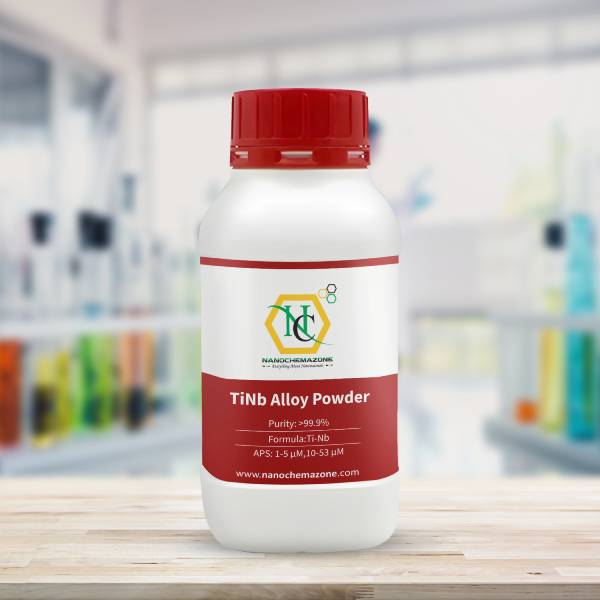
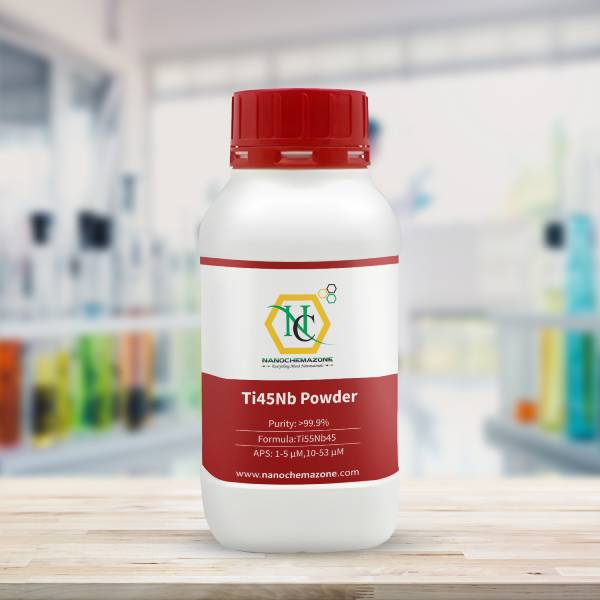
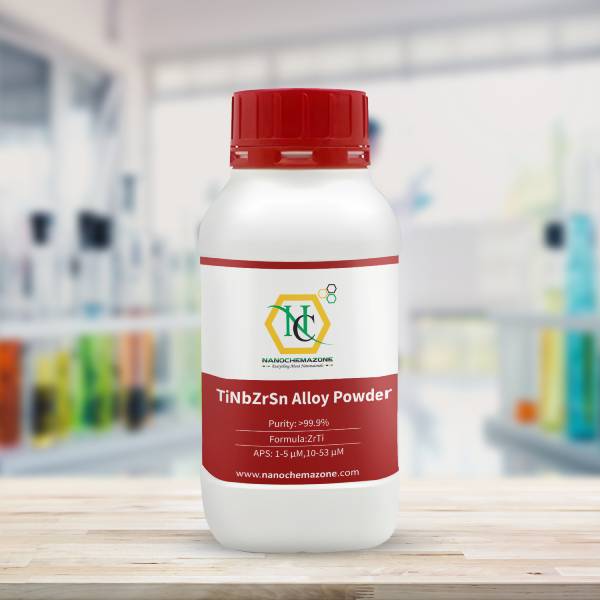
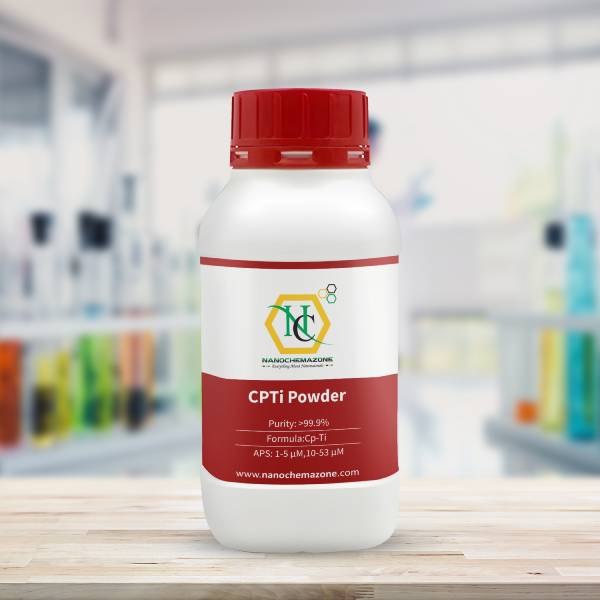
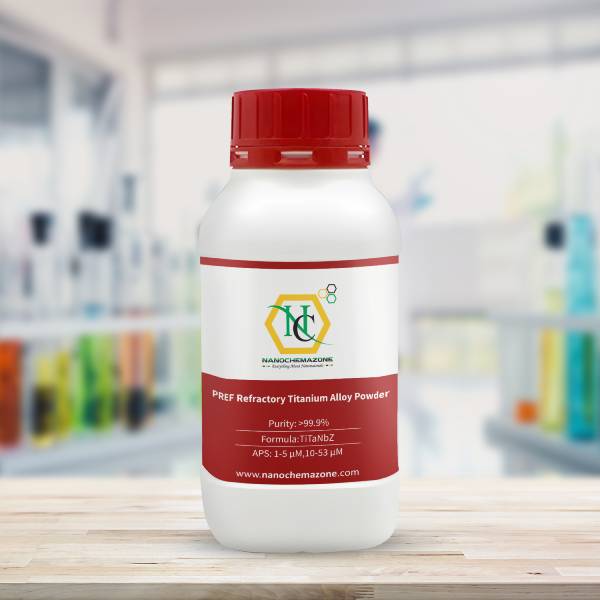
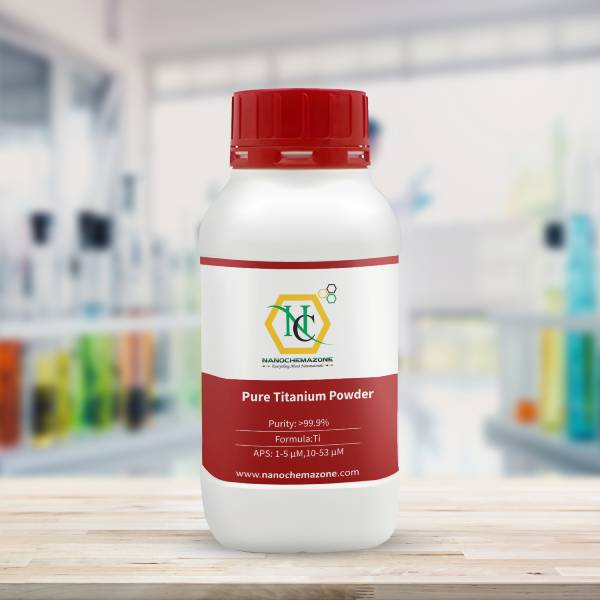
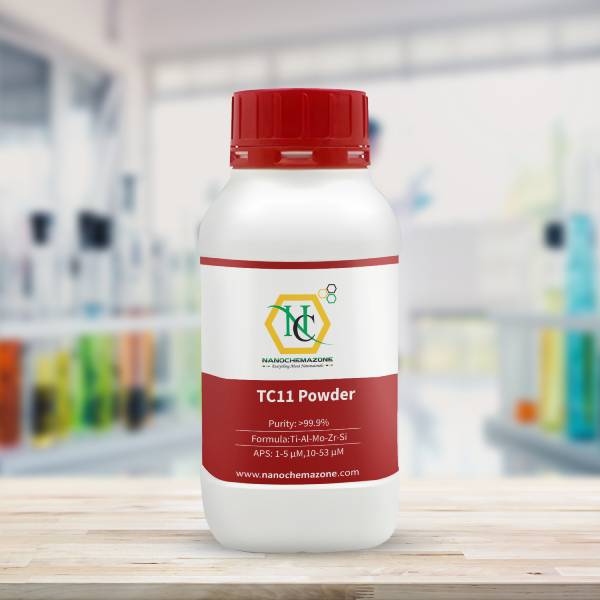
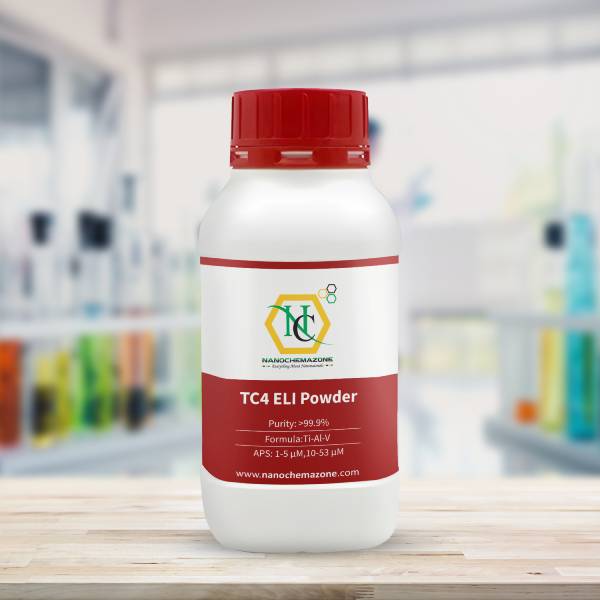
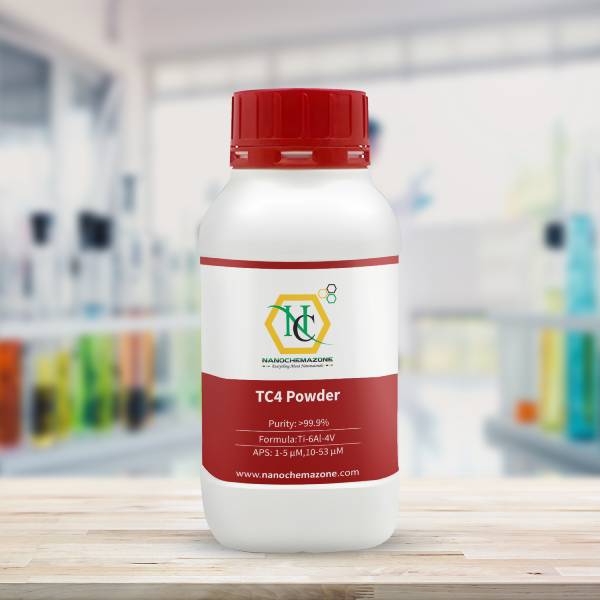
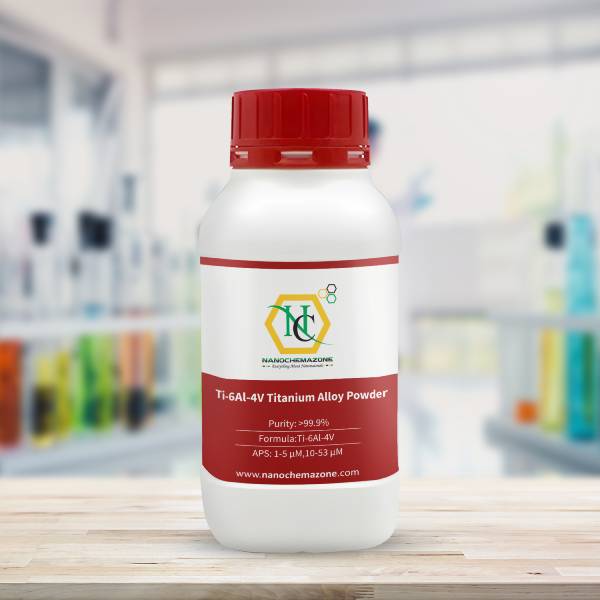
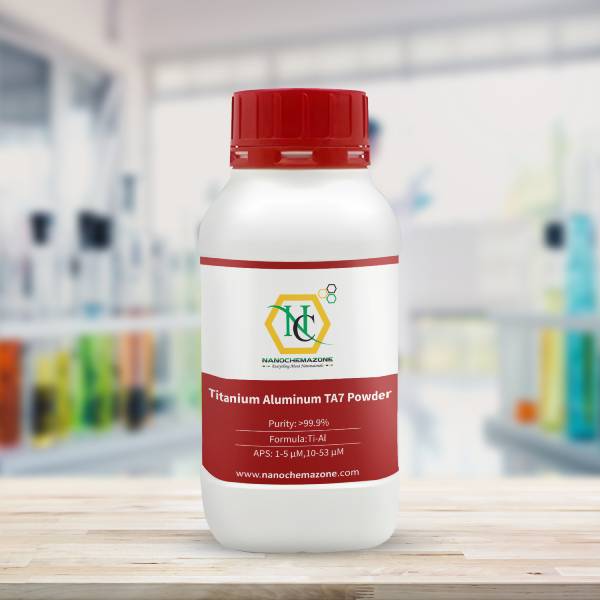
Reviews
There are no reviews yet.